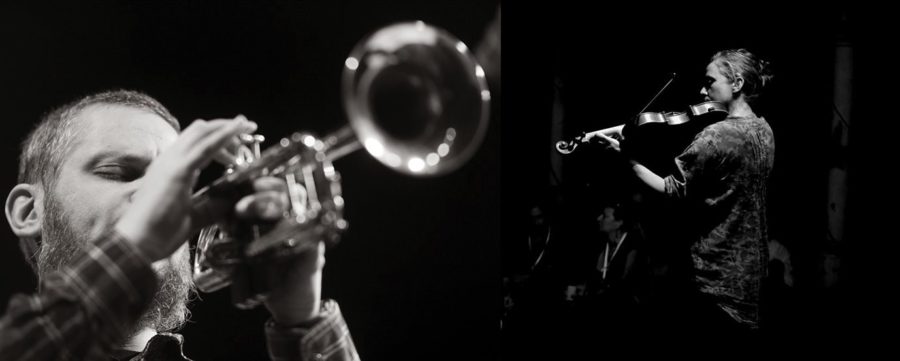“Entities should not be multiplied without necessity.”
Occam’s Razor conceptualizes the ideals of simplicity, in which the greatest depths of knowledge—and what could be known beyond the present knowledge—can be contained and defined within the narrowest of explanations.
It is fitting, then, that Éliane Radigue titled her experimental compositional series Occam Ocean, as it pulses, morphs, and falters upon the same droning pitch between different instruments, positions, and alterations. Appropriately, Occam Ocean was performed last Wednesday in the echoing acoustic space of Bond Chapel, in a program co-sponsored by the Renaissance Society and Frequency Festival 2020.
The program began with trumpeter Nate Wooley’s rendition of Occam X, Radigue’s sole musical composition for the solo trumpet, inspired by Radigue and Wooley’s letter correspondences as well as the Columbia River. Wooley approached the stage in near silence, met with equal stillness from the audience, and sat on his knees, embodying a meditative stance as he slowly raised his trumpet to his lips. For those unfamiliar with Radigue’s musical style, the vivid lack of brass timbre in the piece’s exposition would have been a jarring departure from traditional trumpet solos. Wooley merely blew air through his instrument, and within the hushed walls of Bond, this stream permeated the silence, yet allowed for the audience to hear every imperfection in Wooley’s performance. Every minute pause in the airstream; the accidental warble from the accumulating moisture in the valves; and the tiniest burst of brass buzzing all added to the intimacy of this performance, alluding to the nuanced complexity within the singular ease of breathing.
Wooley then explored this identical pitch with alterations to his trumpet, picking up a Harmon mute at one point, pointing the trumpet bell at a thin sheet metal the next. The mute dissipates the trumpet’s sound, which becomes nearly reedy in its undulation and hollows out with its removal. With the sheet metal, a rattling hiss weaves into the trumpet’s drone, which was interpreted in various ways by the audience—at times, the musical effect clashed with the mellow harmonics, before complementing themes of fluidity, vibrations, and flow to create ocean-like imagery. To conclude Occam X, Wooley propped himself up on his knees, and, while twisting his torso left and right, performed a startlingly low pedal tone, which wavered in pitch as he turned and inhaled sharply to continuously maintain the note. From merely blowing into the instrument to adding further kinetic characteristics, Wooley’s rendition of Radigue’s experimental composition embodies the delicacy, care, and sustainability of a simplicity that encompasses extreme intricacy.
Violist Julia Eckhardt followed with her performance of Occam IV, an originally improvised piece composed through numerous exchanges between Eckhardt and Radigue. Similar to Wooley, Eckhardt initiated her show by running her bow across the viola strings, creating a softly screeching, barely trembling sound quite unlike the usual timbre of the instrument. Inspired by the repetitive lapping of ocean waves, the work gradually encompassed the viola’s full richness, sustaining one continuous tone with the rocking motion of water mimicked by the movement of the bow. Eckhardt moved her bow further along the fingerboard, until the bow was literally inches away from the tip of the neck. The sound grew more feeble, fragile, and subdued, like the remnants of a crashed wave lapping weakly at the shore before retreating. Almost hypnotically, the bow slid back to the bridge for the second half of Occam IV, resolving the tensions of her hand placement, and the tone returned to the initial soft quivering before fading to silence.
Perhaps this duality of simplicity and complexity, and the imitation of the fluidity of water are the main aspects of this performance, but the final piece, the duet Occam River XXVI, emphasizes the intense control that undergirds the musical series. Radigue has stated, “Rather than the virtuosity of speed, [my music] concerns the virtuosity of absolute control of the instrument.” Truly, this duet demands the highest degree of synchronization between the two musicians, as one fumbling buzz from the trumpet could break the delicate wavering of the viola, and vice versa. However, within this piece exists a paradox: By focusing so much on the necessity of extreme control, this piece breaches the traditional notion of control itself. Without a meter, a set rhythm, a melody, or even a range of pitches, the piece in itself challenges the limits of traditional musical control by abandoning it altogether. In denying musical freedom, it actually embraces it—the ironic beauty behind the conception of Radigue’s experiment.
That said, one caveat of the performance was that the music not only tested the musicians’ control and agency over their instruments, but their captivation of the audience as well. In this sense, the control absolutely faltered and faded: The musicians are not completely at fault, as humans are inclined to feel fatigued at an endless, dreary pedal tone, but several members of the audience had nodded off, closing their eyes and falling asleep to the hypnotic effect. Perhaps it was boredom, perhaps it was simply a spellbinding trance. Nevertheless, it had lost some people’s attention along the way, which could arguably be the most ironic loss of control in this performance.
Occam Ocean was a clever idea, welded together by the infinite expansion of a simple wavelength’s details and the paradoxical duality between musical control and sound liberation. Whether its message resonated with an audience member or not is left up to the listener—upon awakening, naturally.









